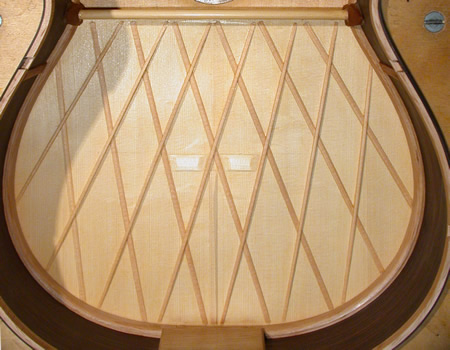Welcome to the Workshop...
There is much content in the Workshop from the old site that can now be found on the next page. Since most of that content was developed, my guitars have changed in one very significant way: for the past few years I have been working with a lattice bracing system for the lower bout of the soundboard. Here are pictures of two instances of this system.  Before I get into the specifics, I would like to try to dispel a few misconceptions about "lattice-bracing". The most well-known lattice-braced guitars are those of Greg Smallman and his followers in Australia. These guitars tend to have a rather unique set of sound characteristics. By reputation, they sound quite distinct from a traditional guitar like a Torres. It has become commonplace, particularly among players, to use the term "lattice-braced" to characterize the sound associated with Smallman guitars. Thus, if a guitar is described as "lattice-braced", for many players the expectation is that it will sound something like a Smallman. However, many luthiers around the world employ lattice systems that give diverse results quite unlike the Smallman "sound". It would be a mistake to pigeonhole lattice guitars this way. Just as fan-braced guitars can embody a rich and wide range of sonic personalities, so can lattice-braced guitars. In fact, I expect that just as much variety can be found among lattice- as among fan-braced guitars. Further, the potential overlap in results between the two systems is considerable.
Before I get into the specifics, I would like to try to dispel a few misconceptions about "lattice-bracing". The most well-known lattice-braced guitars are those of Greg Smallman and his followers in Australia. These guitars tend to have a rather unique set of sound characteristics. By reputation, they sound quite distinct from a traditional guitar like a Torres. It has become commonplace, particularly among players, to use the term "lattice-braced" to characterize the sound associated with Smallman guitars. Thus, if a guitar is described as "lattice-braced", for many players the expectation is that it will sound something like a Smallman. However, many luthiers around the world employ lattice systems that give diverse results quite unlike the Smallman "sound". It would be a mistake to pigeonhole lattice guitars this way. Just as fan-braced guitars can embody a rich and wide range of sonic personalities, so can lattice-braced guitars. In fact, I expect that just as much variety can be found among lattice- as among fan-braced guitars. Further, the potential overlap in results between the two systems is considerable.
 My own approach has been to exploit this potential for overlap and try to duplicate and extend the sound I get with more traditional fan-bracing. To do this I have, in essence, taken two sets of 7 fans and rotated them with respect to each other to form a lattice, one tall set riding over a low set. This approach mimics the increased support in front of the bridge inherent in a fan-braced design, but introduces the main advantage of a lattice, which is to give more uniform support to the entire soundboard. Of course, when I say support, I mean graded stiffness and mass that can influence the sound in myriad ways. In the first picture you will also notice a transverse bar under the bridge. This gives another component to work with. Overall, this system is extremely versatile. I look upon it as an extension of fan-bracing rather than an alternative.
My own approach has been to exploit this potential for overlap and try to duplicate and extend the sound I get with more traditional fan-bracing. To do this I have, in essence, taken two sets of 7 fans and rotated them with respect to each other to form a lattice, one tall set riding over a low set. This approach mimics the increased support in front of the bridge inherent in a fan-braced design, but introduces the main advantage of a lattice, which is to give more uniform support to the entire soundboard. Of course, when I say support, I mean graded stiffness and mass that can influence the sound in myriad ways. In the first picture you will also notice a transverse bar under the bridge. This gives another component to work with. Overall, this system is extremely versatile. I look upon it as an extension of fan-bracing rather than an alternative.
The resulting guitars are typically better than their fan-braced siblings in almost every regard. There tends to be more "presence" to the note without sacrificing sustain; richer, bigger basses; excellent evenness from note to note and string to string; and great clarity and projection. Yet if you compare one directly to an older fan-braced "Byers", you will find the timbral palette is remarkably similar. Overall, the transition from one system to the other has been smooth and successful. Confirmation of this has come from David Russell, who recently purchased one.
